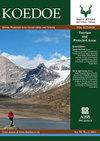南非自然保护区昆虫病原线虫(Steinernematidae和Heterorhabditidae)的分布和多样性
IF 1.1
4区 环境科学与生态学
Q3 BIODIVERSITY CONSERVATION
引用次数: 0
摘要
昆虫病原线虫(EPNs)是在世界各地土壤中发现的微小蛔虫。它们通过利用昆虫的土壤阶段作为食物来源和作为天然生物防治剂,通过防止昆虫繁殖中的自然耀斑,提供了重要的生态系统服务。在南非西开普省Stellenbosch的JS Marais自然保护区进行了一项epn调查。以冷蛾(Cydia pomonella)、蜡蛾(Galleria mellonella)和粉虫(tenbrio molitor) 3种易感寄主幼虫为饵,测定土壤样品中EPN的存在。76份土壤样品中EPN阳性39份(51.32%);在阳性样本中,87%为斯坦氏菌分离株,8%为异habditis分离株,5%为Oscheius sp分离株。在物种水平上对分离株进行了形态学和分子研究。在34份样品中鉴定为斯坦内马·科伊桑斯坦内马,在5份样品中鉴定为斯坦内马·格尼斯坦内马。唯一发现的异habditis种是南非血吸虫(H. safricana),它是从三个样本中鉴定出来的。在两个样本中发现了一种未知的Oscheius sp.。保护区种群在ITS区域早期表现出有趣的个体间变异(93%),导致单可用序列较短,在大多数情况下仅包括ITS1或ITS2区域。然而,使用D2D3证实了它们的身份是S. khoisanae,它们在保护区的所有地区和土壤类型中都有发生。保护意义:JS Marais自然保护区未受干扰的冲积滩地和草地显示出较高的EPN丰度和多样性,与开普区植物区系的农业生态系统形成鲜明对比。在微观层面上,这一发现应该被保留下来,以便将来在fynbos中寻找具有生物防治潜力的epn。本文章由计算机程序翻译,如有差异,请以英文原文为准。
Distribution and diversity of entomopathogenic nematodes (Steinernematidae and Heterorhabditidae) in a South African nature reserve
Entomopathogenic nematodes (EPNs) are microscopic roundworms that are found in soil worldwide. They deliver an important ecosystem service through preventing natural flares in insect reproduction by means of utilising the soil stages of insects as a food source and by acting as natural biocontrol agents. A survey of EPNs was conducted in the JS Marais Nature Reserve, Stellenbosch, in the Western Cape province of South Africa. Soil samples were baited with the larvae of three susceptible hosts, codling moth (Cydia pomonella), wax moth (Galleria mellonella) and mealworm (Tenebrio molitor) to determine the presence of EPN. Of the 76 soil samples collected across the reserve, 39 were found to be positive for the presence of EPN (51.32%). Among the positive samples, 87% contained Steinernema isolates, 8% contained Heterorhabditis and 5% contained the Oscheius sp. Morphological and molecular studies were performed to characterise the isolates to species level. The Steinernema species were identified as Steinernema khoisanae in 34 samples, and as Steinernema nguyeni in five samples. The only species of Heterorhabditis found was H. safricana, which was identified from three samples. An unknown Oscheius sp. was found in two samples. The reserve’s population of S. khoisanae showed interesting inter-individual variation (93%) early in the internal transcribe spacer (ITS) region, leading to short single-usable sequences, which, in most cases, included only the ITS1 or ITS2 region. However, using the D2D3 confirmed their identity as S. khoisanae, with such occurring in all areas and soil types of the reserve.Conservation implications: The undisturbed alluvial fynbos and renosterveld of the JS Marais Nature Reserve showed high EPN abundance and diversity in stark contrast to the agro-ecosystems present in the Cape floristic region. This finding, on a micro level, should be conserved for future bioprospecting in the fynbos for EPNs with potential as biocontrol agents.
求助全文
通过发布文献求助,成功后即可免费获取论文全文。
去求助
来源期刊

Koedoe
BIODIVERSITY CONSERVATION-
CiteScore
3.30
自引率
0.00%
发文量
10
审稿时长
20 weeks
期刊介绍:
Koedoe, with the subtitle ''African Protected Area Conservation and Science'', promotes and contributes to the scientific (biological) and environmental (ecological and biodiversity) conservation practices of Africa by defining the key disciplines that will ensure the existence of a wide variety of plant and animal species in their natural environments (biological diversity) in Africa.
 求助内容:
求助内容: 应助结果提醒方式:
应助结果提醒方式:


